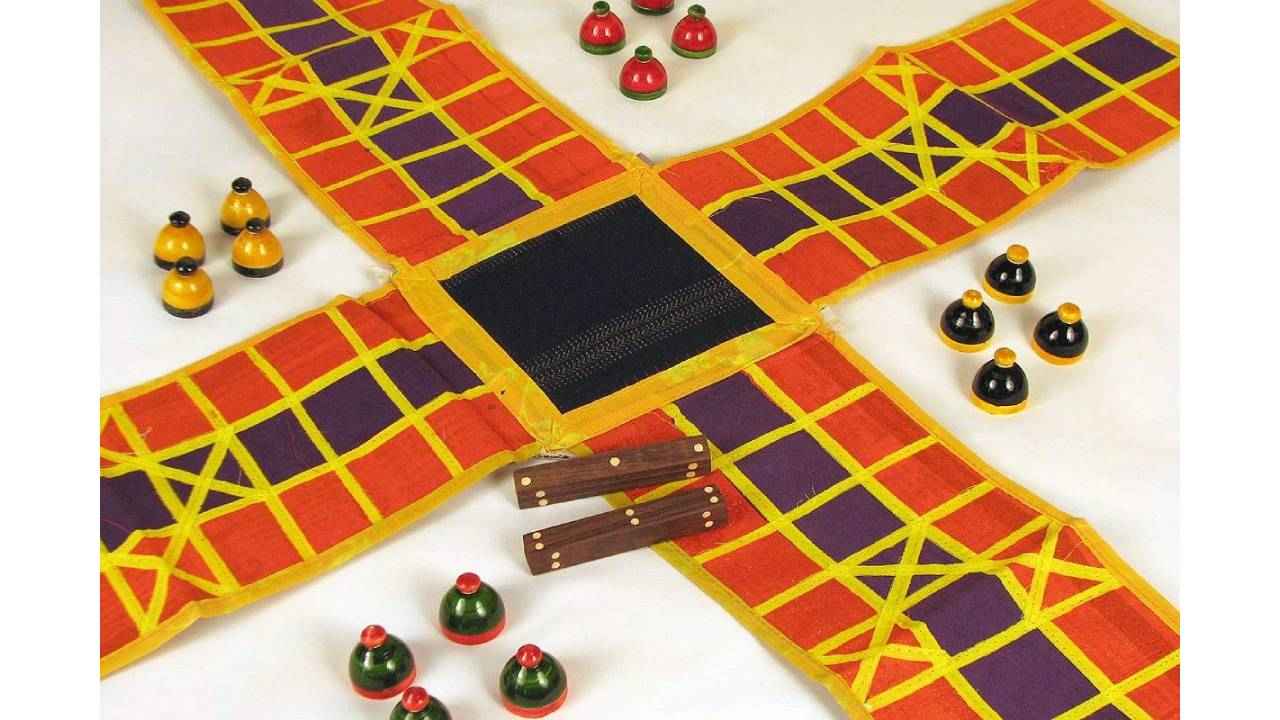Traditional Indian tabletop games

India has a rich history of traditional indoor games. A variant of pachisi was played in the Mahabharata, but we no longer know the exact rules. According to legend, Shakuni used a 4 sided dice made from the bones of his ancestors. In the Ramayan, Ram played a variant of mancala with Sita and won. Later on, Sita played a solitaire version of mancala called Sithaipindi in Lanka. This makes Sita perhaps the earliest recorded speedrunner. Kirshnaraja Wodeyar, the king of Vijaynagar was an avid gamer and designed a number of checkers or hunt games. Actually, most of these games are not even played on the table, so a more accurate term would be traditional Indian sedentary games, which means the games that are played while sitting. The games below are known around the country by different names, and there are also many variations in rules. The most important thing in these games are not the boards, which are often made of cloth, but the game pieces. Once acquired, different game boards can be drawn up from any handy material, such as slate and chalk, marker and cardboard, or acrylic paint and handkerchiefs.
 Survey
SurveyAncient Living Puli Mekaa
Aadu Puli Aatam, also called Wagh Bakri, Bagh Chaal and Pule Mekaa is an asymmetrical hunt game, where a few predators hunt a number of preys. The predators can be tigers, leopards or wolves, while the prey can be lamb, sheep or cows. Often the pairing is tigers and cows, leopards and goats, and wolves and lambs. There are three predator tokens and fifteen prey tokens in this game. This is a game played between two people and typically lasts about an hour. The predator has to jump over the prey to kill it while moving along the lines of the grid. The preys cannot jump over the predators but have to manoeuvre around the board to checkmate the predators so that they have no opportunity to make another move. Children as young as six can pick up the mechanics and play this game, but it is equally fun for adults as well.
Kreeda Ashtaa Chemma
Ashta Chemma also known as Chowka Bara is very popular in south India. Please note that the game does not come with the tiger cowrie shells traditionally used with the game, which have to be purchased separately. Instead, the dice is made up of paper, which is great if you want to avoid using products derived from animals. This is essentially a title like Ludo, where up to four players have to race each other around the board, the first circuit in an anticlockwise direction, and the second inner circuit in a clockwise direction. Depending on the rolls, a single game can last even two hours, but a game typically finishes within forty minutes. This is the junior variant of the board, with five columns, and not the senior variant with six columns. However, the game board is versatile and can be used to play other games such as Wagh Bakri and Ashte Kashte.
Simple Days Pachisi Pagade Thayam Chaupad Ludo
This is a Chaupar board, but the same can be used to play Pachisi and Chausar also. Although the three are often considered to be the same game, they are not. Pachisi is played with cowrie shells, Chaupar is played with four-sided dice, and Chausar is played in teams with three dice, each of which is four-sided. There are two dices with this game, so actually the game is Chaupar. The dices have faces of 1,3,4,6 and are not the alternative 1,2,5,6 variant. Unlike Ludo, instead of starting from the corner, you start from the middle and end in the middle. Two pieces can also team up to form a pair, which can then move together. A pair can only be killed by another pair. Ask your grandparents for the rules of this game, and maybe even invite them for a round or two. If you can get between five to seven cowrie shells, or rub off a single side of five to seven tamarind seeds to use as dice, even Pachisi can be played with the same board. Buying this will give you the pieces required for three games, each with many variations.
Kumar Pallanghuzi/Mancala Wooden Board Game
This is mancala, and the game has two rows of seven holes. The same board supports various kinds of mancala games popular across the region. For example, the Ali Guli Mane variant popular in Karnataka can be played with a player using each side of the box. A variant from north India, Kanji Gutti can be played with one player claiming six of the holes to the right, the other claiming six of the holes to the left, and two central holes being neutral. The Tamil Nadu version of Pallanguli can also be played using the same board. Then, the central Indian version of Sat Gol can be played using just the 7 holes on one side. The solitaire version, known as Sithaipindi can be played using the entire board. The game comes with 75 cowrie shells which are plenty to support all these variations. Boards or seeds can also be used with this game instead of the shells. A nice artistic touch is that the box is shaped like a fish when closed.
Aditya Madanapalle
Aditya Madanapalle, has studied journalism, multimedia technologies and ancient runes, used to make the covermount DVDs when they were still a thing, but now focuses on the science stories and features. View Full Profile